NYC Fluid Retail: Hospitality Edition
New York Market Week and NYCxDESIGN are fast approaching and as retail continues to rapidly transform, we’re looking beyond the immediate industry, to environments and concepts inspiring the retail of tomorrow. Today’s consumers engage with brands in a fluid manner, the traditional sectors of the retail, restaurant, hospitality, and entertainment have blurred as the consumer-desired experience has become a mosaic of expectations, influenced heavily by engagement, access, and authenticity. Embracing these new expectations presents brands with a greater opportunity to differentiate, cross-sell and expand the breadth of their brand experience. So, this year while in the city we’ll be exploring some of the city’s most innovative new concepts across multiple industries, that we think could be a driving force in the retail experience of the future.
Our first #FluidRetail post featured Food + Beverage, while this next segment will focus on Hospitality + Wellness concepts, with more markets showcased in the coming weeks. Below you will find the best spots in and around NYC to stay, work, relax, or simply indulge in some self-care.
Sister City NYC | Lower East Side Hotel
Described as an “experiment in essentialism”, Sister City is a newly opened hotel touting the “lean luxury” trend. The hotel has taken inspiration from minimalists and “functional perfection of Finnish saunas, Japanese bento boxes, rock-cut cliff dwellings of prehistory.”
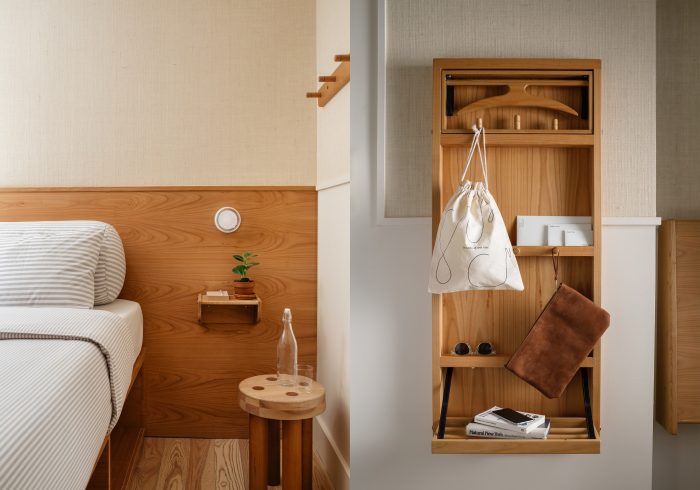
Chill House NYC | East Village Salon + Coffee Shop
Chill House is a coffee shop, nail salon, and massage boutique all in one. The space’s cool-vibe aesthetic makes this the perfect spot to treat yourself to some self-care and grab a gourmet cup of joe. One can come in for a single visit or purchase a membership plan offering exclusive discounts and products.

3DEN | Co-Working In Hudson Yards
This new concept located at Hudson Yards offers work spaces, Casper nap pods, showers, a meditation room, soundproof phone booths, and coffee and snacks in a spacious, plant-filled. Visiting 3DEN can be done through the company’s app where users can see what available or how crowded the space it.
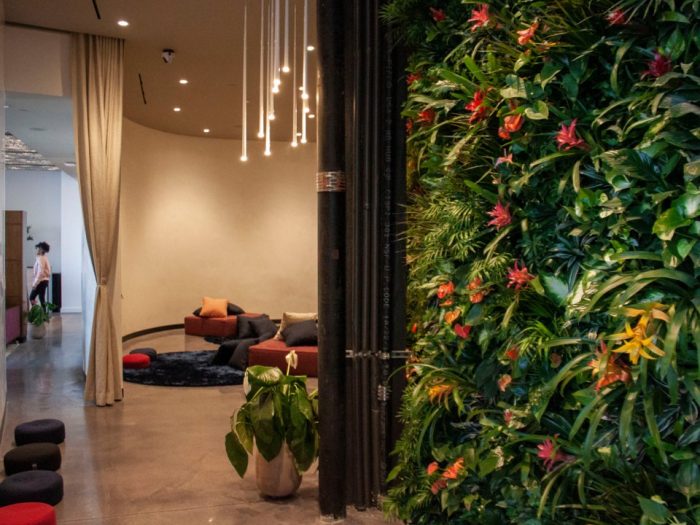
Rise By We | FIDI Gym
WeWork’s first ever gym location opens in NYC. The concept is available for WeWork and non-WeWork members. Featuring everything you’d expect in a gym; the space’s color palette is muted with black and light wood finishes and splashes of greenery.
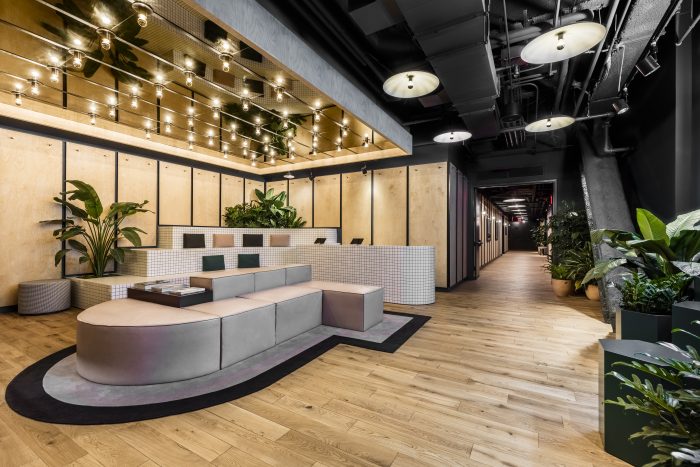
The Refinery | Mid-Town Hotel
Refinery Hotel is a reinterpretation of the Colony Arcade—a former hat factory and Prohibition-era tea room. Each room has been transformed into a stylish loft room with high ceilings and luxury accents. The Refinery Rooftop is the hotels crowning jewel with inspiring views of the Manhattan skyline and Empire State Building.
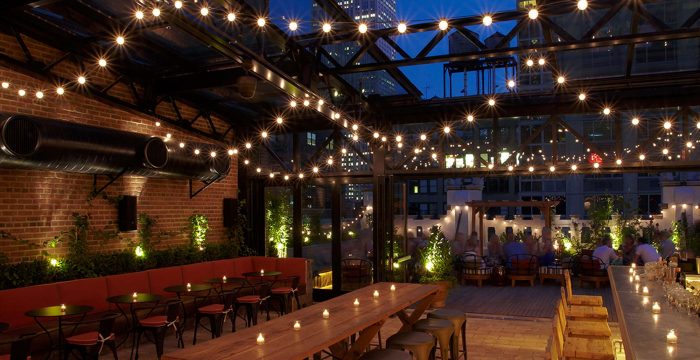
Greenery Unlimited | Brooklyn Biophelia
Plant stores are having a big moment and Greenery Unlimited located in Greenpoint, Brooklyn was modeled after biologist Edward O. Wilson’s theory of biophilia, which suggests that humans feel better and are healthier when surrounded by natural life. At this store, you’re encouraged to sit back, relax, and maybe buy a new plant.
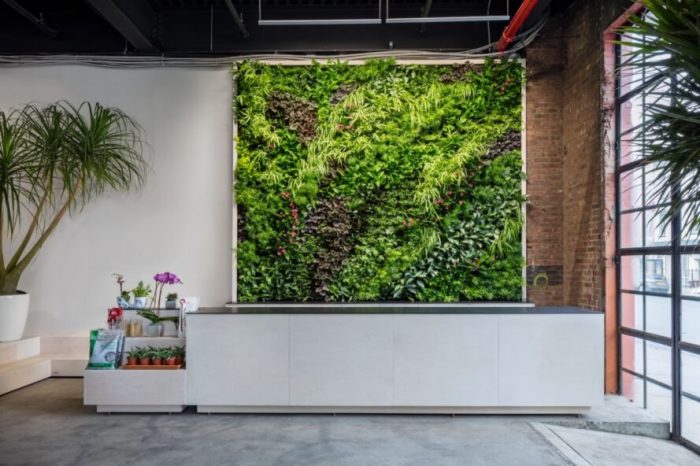
The Assemblage Nomad | FIDI Extended Stay + Co-Working
The Assemblage located in FIDI is a unique property offering a co-working space and flexible extended stay booking that takes a spiritual approach by providing visitors a holistic, ayurvedic, work-play-live space.
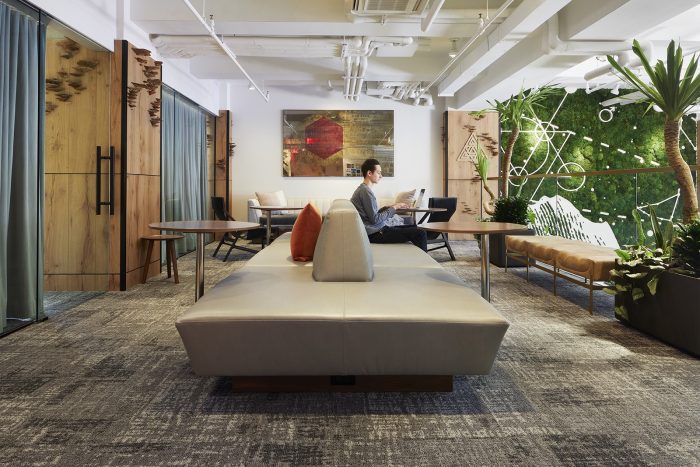
Recreation At The Moxy | Downtown Hotel
The Moxy Hotel in downtown NYC introduces a new concept featuring a co-working space by day and a cocktail lounge with a basketball court by night. The concept taps into Moxy’s play-and-games ethos and creates a hospitality hub that can cater to a variety of needs.
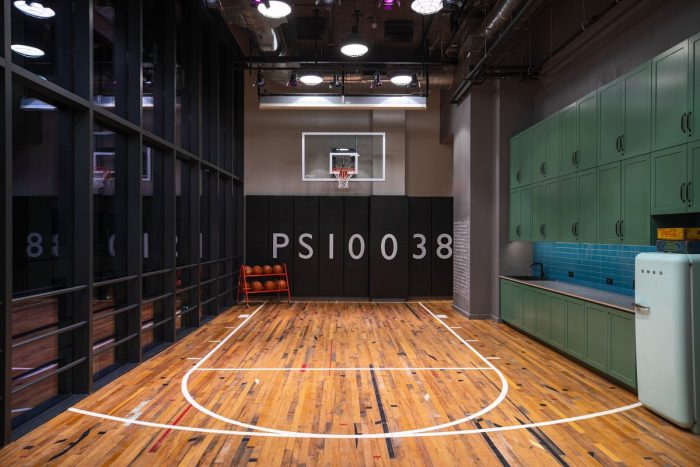
Recess CBD | NOHO Pop-Up
CBD company Recess has opened a pop-up experience in NOHO inviting visitors to step into a laid-back, neon-filled shop space that serves the brands sparkling water infused with hemp extract. The idea is to draw people into the space to learn more about the brand and relax.
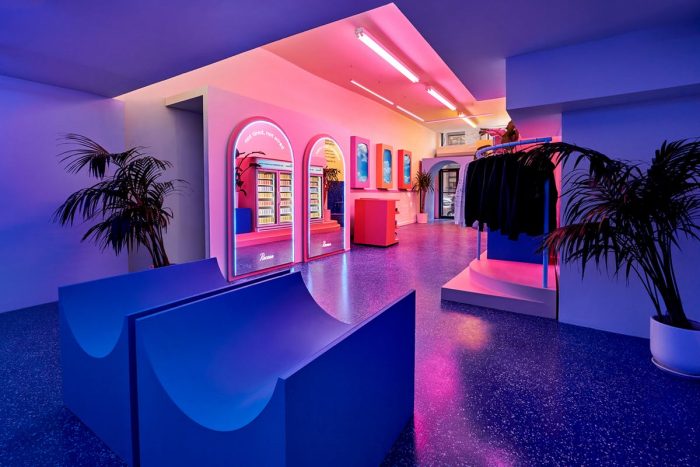
Teammate Spotlight: Meet Linda Mysliwiec
Meet Linda Mysliwiec, Workplace National Business Leader at NELSON Worldwide. With an in-depth background in design and a strong business acumen, Linda will lead the firm’s nationwide workplace business efforts while looking to inform and translate business strategies into execution.
Q: If you had 3 words to describe your brand, what would they be?
Fair, Fun, Honest
Q: What’s something people don’t know about you that they would be surprised to find out?
I’m half Panamanian, half Polish.
Q: What is a quote or mantra you live by?
I attempt to find the best in others. I also try to live by the idea of ‘equanimity’ – I tend to remain calm, even when under stress or while having a disturbing experience (this has been tested during the pandemic)!
Q: What is an underrated food that you think deserves more hype?
Sardines.
“I hope to bring balance with my technical background, but also people-focused mentality. I want to bring a business-minded focus to our practice, but also keep our office communities happy and focused on great work for our clients.” – Linda Mysliwiec
NELSON Takes Honors At IIDA New England Design Award
NELSON Worldwide teams on won Best in Show from 74 entries in 11 categories during the International Interior Design Association (IIDA) New England Design awards ceremony. Their project for Google really impressed the judges who remarked, “[They] nailed the east coast feeling and touches on all elements from NY to Rhode Island. Whimsical and fun with very clever and bold design elements. The extensive variety of spaces with distinct personalities like the rail car elevator lobby, the English designed room, use of prison beds for a collaborative area and boats on the ceiling remind you that you are on the coast. Great example of eclectic and exciting design.” Congratulations to the teammates who spent countless hours making this project a success!
Music Hall Renovation
A local project in our own backyard, FRCH NELSON’s Hospitality and Retail-Mixed Use studios have teamed up on the renovation of Cincinnati’s iconic Music Hall. We were tasked with an overhaul to the environmental graphics and wayfinding strategies in addition to the FF&E packages for the Symphony Offices. As a treat for all our hard work, some lucky FRCH-ers were offered the chance at a behind-the-scenes tour of the renovation-in-progress – before they close the doors until the grand re-opening in early October.
Some additional Music Hall facts:
- It’s the sixth oldest symphony orchestra in the U.S. and the oldest orchestra in Ohio, houses the largest symphony music library in the U.S.
- It was built in 1878, this classic entertainment venue is considered one of the best and most beautiful concert theaters in the world, and was designated a National Historic Landmark in 1975
- Music Hall originally served the city as its first convention center
- Music Hall was built over a pauper’s cemetery, which has also helped fuel its reputation as one of the most haunted places in America
Bloomie’s
Celebrating NELSON’s Female Leaders
For Women’s History Month, NELSON would like to celebrate some of our female powerhouses. These women have proven that hard work and determination can take you beyond your wildest dreams. Read below to learn from their valuable insight and feel inspired.

Ramya Shivkumar
Director of Energy & Sustainability, Windward
—
If you could give one piece of advice to young female professionals, what would it be?
Be the architect of your own career. Be curious, have an abundance mindset, and define what success means to you.
Past or present, name three women that you would invite over for a dinner party?
Michelle Obama, Wangari Maathai, JK Rowling, and the fourth lady would be my mom, whom I admire for her tenacity and ability to help many less privileged people.
What do you want to be remembered for?
I want to be remembered as someone who could bring people together, empower and inspire them to make the world a better place for future generations.
Chen Hui Spicer
Regional Design Leader, Director
—
When did you first become interested in design/architecture?
There are many reasons why I decided to pursue interior design at a young age. One of the most important was my passion for creativity and self-expression. Interior design allows me to combine my love of art and design with my desire to create functional and beautiful spaces. Whether I’m designing a home, office, or retail space, I get to use my creativity to make a real impact on people’s lives.
Another reason was my interest in architecture and construction. I’ve always been fascinated by how buildings are constructed and how they can be designed to be both functional and aesthetically pleasing. As an interior designer, I get to work closely with architects and contractors to ensure that the spaces I design are not only beautiful but also structurally sound.
Additionally, I believe that interior design can have a profound impact on people’s well-being. Studies have shown that well-designed spaces can improve productivity, reduce stress, and even promote healing. As an interior designer, I have the opportunity to create spaces that not only look good but also make people feel good.
Finally, I believe that it’s a field that is constantly evolving and changing. With new technologies, materials, and design trends emerging all the time, there is always something new to learn and explore. This keeps me engaged, motivated, and ensures that my work is always fresh and innovative.
I am excited to see where my career in interior design will take me, and I look forward to creating beautiful and functional spaces for many years to come.
If you could give one piece of advice to young female professionals, what would it be?
My advice is to prioritize communication and collaboration with their team and clients, actively listen to others, establish a clear workflow and process for feedback, and stay up to date with industry trends and best practices. By following these strategies, they can produce high-quality designs and build positive working relationships with their team and clients.
Past or present, name three women that you would invite over for a dinner party?
I would choose Zaha Hadid, Kazuyo Sejima, and Neri Oxman.
Zaha Hadid was an Iraqi-British architect and designer who became one of the most important architects of the 21st century. She was the first woman to receive the Pritzker Architecture Prize, and her designs have been featured in numerous prestigious museums and galleries around the world. Her innovative approach to architecture and design, blending fluid forms and cutting-edge technology, would make for a fascinating conversation.
Kazuyo Sejima is a Japanese architect and co-founder of the Tokyo-based firm SANAA. She has designed a range of projects, from small-scale residential homes to large-scale public buildings, and has received numerous awards for her work. Her minimalist approach to design and use of natural light and open spaces would be an inspiring topic of discussion.
Neri Oxman is an Israeli-American architect, designer, and professor at MIT’s Media Lab. She is known for her pioneering work in the field of “material ecology,” a concept that combines biology, technology, and design to create new forms of architecture and design. Her innovative approach to sustainable design and use of new materials would make for a thought-provoking conversation.
Together, these three women represent the forefront of innovation and creativity in the field of architecture and design. Their contributions to the field have helped to shape the built environment in new and exciting ways, and their perspectives on the future of design would be a fascinating topic of discussion. I would be honored to host them for a dinner party.
What do you want to be remembered for?
What each designer wants to be remembered for is a deeply personal and individual decision that is informed by values, goals, and aspirations. Some common themes that many designers strive for in their work include innovation, creativity, and making a positive impact on society. Another aspect that could set me apart as a designer is my commitment to pushing the boundaries of what is possible. This could involve experimenting with new materials, technologies, and techniques to create designs that are truly groundbreaking. By embracing innovation and pushing the limits of what is possible, I can inspire future generations of designers to continue to explore new frontiers in design.
Ultimately, I want to be remembered as a designer that is striving to create designs that make a positive impact, that push the boundaries of what is possible, and that reflect my unique creative vision and values, which I can leave a lasting legacy that will inspire and empower future generations of designers.

Jennifer Acevedo
Principal, Marketing & Brand Strategy
—
When did you first become interested in design/architecture?
I’ve been interested in design/architecture and the arts for as long as I can remember. My mom is a retired ASID interior designer and my sister is a fine artist, photographer, and painter. Our love of design and the built environment as well as a love of travel was nurtured in us from the time we could pick up a crayon, and while my talents lie elsewhere (can’t draw to save my life), I have enjoyed a lifetime appreciation of and education about design in its many forms.
If you could give one piece of advice to young female professionals, what would it be?
This would be the same advice I’d offer any young professional…find your passion and pursue it and commit to a lifetime of learning and new experiences. I strongly believe that learning is growing and that there is power in answering a question, “I don’t know, but let me find out.” Not only does this keep us humble, no matter what stage of our career we are in, but it reminds us that no one has all of the answers and also nurtures the natural curiosity we are all born with but that only some carry with them into adulthood.
Past or present, name three women that you would invite over for a dinner party?
First Lady Eleanor Roosevelt, painter Frida Kahlo, and Poet and Activist Maya Angelou. All three are sources of major inspiration for me, and not coincidentally, all three have made an indelible mark on me by speaking their minds, standing up for what they believe in, and advancing the causes of human rights, regardless of popular opinion.

Sara Steinbauer
Principal, Business Infrastructure
—
When did you first become interested in design/architecture?
I am not actually a designer or architect. My training and background are in Information Services…all because my 5th grade teacher (a very long time ago) declared that computers would give us the 4-day work week and I wanted in on making that happen. However, I did intentionally seek out working design/architecture firm after working for Project H.O.M.E. I was part of a leadership team responsible for building a 39K SF Community Technology Center in lower North Philadelphia. I fell in love with the process and people.
What lessons and experiences can you share as a female leader?
Learn to harness your own personal agency; Perfection is overrated; Learn to embrace failure for what it is — taking risks, learning, feeling good about at least having tried and trying again; Continuously learn, grow and be open-minded to new perspectives, ideas, and ways of doing things; Don’t hesitate to ask questions and for help when needed…and be there to give answers and help when asked.
Past or present, name three women that you would invite over for a dinner party?
Most difficult question of all! Let’s go with Indra Nooyi, Amanda Gorman, and Tina Fey…can you imagine that night?!

Holly Williamson
Regional Design Leader
If you could give one piece of advice to young female professionals, what would it be?
Be a good mentor. At any stage of your career, you can mentor. As a young designer starting out you can mentor students. As a mid-level designer, you can mentor interns. As a Senior Designer, you can mentor intermediate designers. You should always be developing teammates so they can take your position one day and grow, which, in turn allows you to grow. Working to lift each other up is key to working with a great team.
What lessons and experiences can you share as a female leader?
Over the last two years I have realized more than ever the importance of a worklife balance. Being a working mom is hard work and prioritizing some time for me each day benefits both my teammates and my family. Likewise, recognizing when you need to take a day to recharge is especially important. Another lesson I have been sharing lately is what I call “make new mistakes”. Do not be afraid to try something new, share an idea, take a different approach. If it doesn’t work, you will know for next time. Never make the same mistake twice; keep learning, stretching, and most importantly have fun.
Past or present, name three women that you would invite over for a dinner party?
So hard to pick just three: My college roommate Jackie, Ruth Bader Ginsburg, and my aunt Helen, whom I was named after but never met.
Anne Gibson
Regional Design Leader
—
When did you first become interested in design/architecture?
I come from a family of creatives, with my mom as my primary inspiration as a child. As an artist, a weaver and a graphic designer, my mom has always radiated design. Our home was full of iconic furniture I had no clue was significant until I was an adult. This profession was never a question for me – I have always loved art and it was a natural progression for me to follow this path.
If you could give one piece of advice to young female professionals, what would it be?
Find your pack. Being a woman in this industry can be unfair at times and it’s very lonely (and hard!) to try to go it solo. It takes tremendous strength to stand up for what is right and we must support each other. And know that while what you are fighting for today may not be realized in your career, but it could for all the women who will come after you. I highly suggest reading Abby Wambach’s Wolfpack – it’s a quick read and has so many lessons about how important it is to find those people who you can trust.
What lessons and experiences can you share as a female leader?
Be your authentic self. Use your voice. You are smart. Wear matching shoes. Don’t take yourself too seriously. Listen and ask questions. Have fun.
Past or present, name three women that you would invite over for a dinner party?
This is impossible to limit to three… there are so many women I’d love to spend time with. If I had to choose today, I would invite Beyonce, Twyla Tharp, and Leslie Jones.
What do you want to be remembered for?
I hope people think of me as a caring and curious person. I love to create stories in space to enable connections and I love helping other people do what they love – I suppose that’s how I’d like to be remembered.
MaryVictoria Barr
Market Leader
—
When did you first become interested in design/architecture?
My father is an architect, so I pretty much learned what design and architecture was before I could even walk. I grew up in a house that my dad designed, and my first apartment was in a building that my father’s firm converted from office to residential. I didn’t know it at the time, but he was really paving the way for me to follow in his footsteps.
If you could give one piece of advice to young female professionals, what would it be?
Never be afraid of making mistakes. As a client-facing business development professional, I had to get used to talking to strangers and introducing myself confidently, and usually in a room full of much older male professionals. Although it was scary and intimidating at first, I can’t even count the number of great relationships that I still have because of that initial “Hi, I am MaryVictoria, it’s nice to meet you.”
What do you want to be remembered for?
I want to be remembered for being a confident, capable, and genuine professional. Although my job is rooted in sales, I want to be remembered for my ability to build lasting and authentic relationships.
Google Selected for 8th Annual International Design Awards
NELSON’s Boston office was awarded Gold in Interior Design Competition by the 8th Annual International Design Awards for the Google, Cambridge Campus Expansion, Massachusetts Project.
IDA honorary juries examined over 1000 entries submitted by architects and designers of interiors, fashion, products, and graphics from 52 countries throughout the world. After final decisions had been made, the jury rewarded the best professional and emerging designers for their achievements in terms of design, creativity, usability and innovation. Judging was a rigorous process, with winners receiving publication of their work in the International Design Awards Book of Designs. The coveted IDA Trophy will be awarded to all Designer of the Year title winners at the official biennial International Design Awards Ceremony in Los Angeles.
This annual competition recognizes, honors, and promotes legendary design visionaries and uncovers emerging talents in Architecture, Interior, Product, Graphic, and Fashion Design on global level.
The members of the jury included Alice Blackwood Editor, Design Quarterly, Kahi Lee – Host, HGTV’s “Design on a Dime”, Style Network’s “My Celebrity Home”, Melissa Sterry – Interdisciplinary Design Scientist, Founder, Societas,Josh Rubin – Editor-in-Chief, Founder, and Publisher, Cool Hunting, Martin Venzky – Stalling, Senior Advisor, CMU STeP, Jeffrey Nemeroff – Co-Founder, Creative Director, Entra Magazine, Jordan Landes-Brenman CEO, Haute House PR & Marketing, Raj Nandan – Managing Director, Indesign Group, William Menking – Founder, Editor-in-Chief, The Architects’ Newspaper, Nicole Lloyd – Senior Art Buyer, Deutsch, Inc., Rebecca Epstein Kong – Co-founder, Artware Editions, Aaron Kenedi – Editor-in-Chief, Print, Geraldine Grisey – Editor, Punky B Fashion Diary.
PROJECT DESCRIPTION
Google came to NELSON in 2010 looking to design 20,000 SF of office and kitchen/café space. This modest beginning rapidly grew into a 1200-person, multi- building ‘campus’ located in the MIT Kendall Square area of Cambridge, MA. Paramount to the project’s success was the connection of three buildings surrounding a parking garage with two purposefully built infill buildings forming the nucleus of Google’s campus. Google’s corporate design strategy includes creating spaces that reflect each location’s history and character. Visioning sessions held with ‘Googlers’ resulted in a master plan concept based on Boston’s iconic MBTA transportation system, the “T.” Each building is assigned a color coded ‘line’ and each floor a ‘stop.’ Inspired and guided by the stop’s surrounds, the goal was to create a Boston/Cambridge office. Highlights include a Red Line “Kendall Square” stop as the main entrance. Visitors arrive inside a Red Line subway car, setting up the overall campus experience. Other stops include a micro kitchen with real canoes referencing boating on the adjacent Charles River. At “Charles/MGH” Red Line floor, the luxury Liberty Hotel riffs off of the former infamous Charles Street Jail, mixing lavish appointments with real jail cell doors. A Back Bay Victorian row house library pays homage to the Green Line “Arlington Street” stop, but with a modern twist. The historic “Park Street” floor offers an inspired cafe with rooftop garden views interpreted as the Boston Public Gardens. And, at America’s first public beach – the Blue Line’s “Revere Beach” celebrates with a lighthouse and lounge. Nothing is too outrageous to picture, and one-size-fits-all workstations compliment an array of amenities fostering productive ‘alone’ time as well as collaboration. While innovation and creativity are crucial, Google’s metric focus insures that everything meets data-driven criteria. Google has global commitment to sustainability and spaces are LEED Gold or Platinum Certified.
Please join us in congratulating the Boston Team!
Verizon Innovation Center Wins GREEN GOOD Design Award
NELSON has won a 2013 Green GOOD DESIGN Award from the European Centre for Architecture, Art, Design and Urban Studies and the Chicago Anthenaeum Museum of Architecture and Design for its design of the Verizon Innovation Center in Waltham, MA.
Green GOOD DESIGN identifies and emphasizes the word’s most important examples of sustainable design and develops public awareness programs to promote which companies are doing the best job in sustainable design for our world environments.
For 2013 Green GOOD DESIGN, hundreds of submissions were received from around the world. Members of the European Centre’s International Advisory Committee – worldwide leaders in the design industry – served as the jury and selected over 100 products, programs, people and projects as outstanding examples of Green Design from 22 nations.


